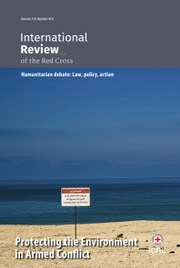Detention – by States and non-State armed groups (NSAGs) – is a reality in armed conflict. In 2021, the International Committee of the Red Cross (ICRC) estimated that around 100 armed groups were holding detainees. Detention puts people in a vulnerable situation: their lives and dignity depend on the detaining authority. Experience shows that detention by NSAGs often presents legal and practical challenges, ranging from a lack of knowledge of international rules and standards on detainee protection, in particular those found in international humanitarian law (IHL), to practical challenges such as how to ensure humane conditions of detention in the dire realities of armed conflict, or how to provide essential judicial guarantees for persons facing criminal charges.
The ICRC's new report on Detention by Non-State Armed Groups: Obligations under International Humanitarian Law and Examples of How to Implement Them presents research conducted by the ICRC on the law and practice relating to detention by NSAGs.Footnote 1 It restates the legal framework for the protection of detainees in non-international armed conflict based on international humanitarian treaties and customary law. At the heart of this publication are a set of examples of measures that NSAGs have taken – or aim to take – to implement their IHL obligations, based on NSAG practices, reported practices and doctrine. These examples were identified from practices witnessed by the ICRC when visiting detainees held by NSAGs; interviews conducted by the ICRC with representatives of sixteen NSAGs; laws, codes of conduct, policies or other documents developed by NSAGs; and practices cited in public reports and academic research. In the study, the emphasis is put on the actual practices, reported practices and doctrine of NSAGs that display an effort to comply with the IHL obligations in question; the research does not focus on practices or doctrine that are contrary to IHL, except where the presentation of IHL violations is deemed helpful to explain misunderstandings of the law.
It is hoped that this study will provide evidence-based examples of how NSAGs can respect and protect detainees. It may also be of interest for States that are considering helping non-State parties to armed conflicts to protect detainees, humanitarian organizations working for the protection of detainees, and researchers working on related issues.


